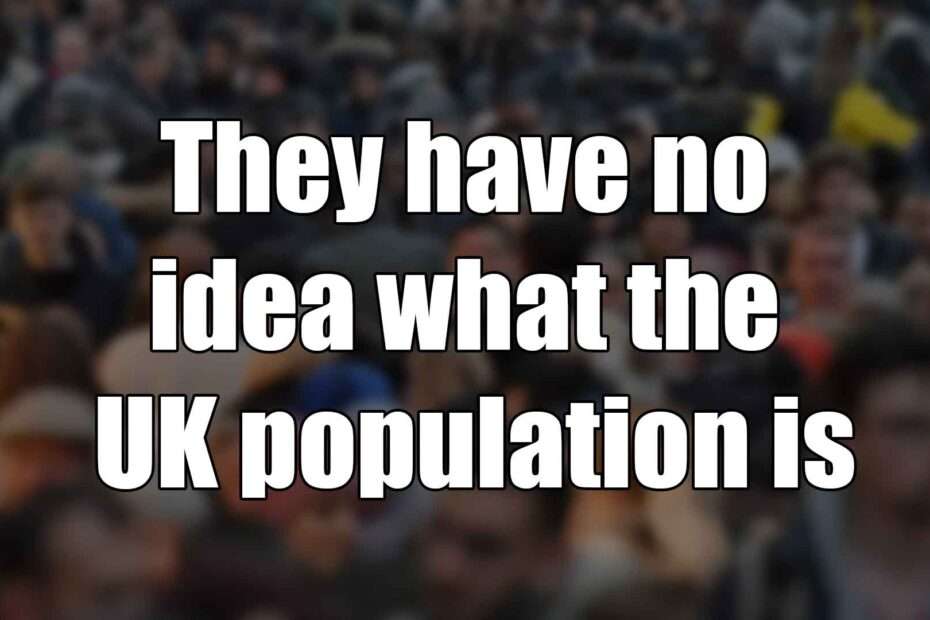They have no idea what the UK population is
Uncertain Population Figures: The Migrant Conundrum in Britain
The scale of illegal immigration in the United Kingdom has once again emerged as a pressing national concern, with recent revelations suggesting that as many as one in twelve residents of London might be undocumented migrants. This startling statistic is likely to be a conservative estimate, hinting at a much more complex demographic challenge facing the nation.
Demographic Uncertainty
Pinpointing the exact number of illegal immigrants in Britain remains an exercise in educated guesswork. The Pew Research Centre’s 2017 estimates ranged from 800,000 to 1.2 million individuals, with a recent consultancy study for Thames Water building upon these figures. However, the critical concern lies in the potential growth of these numbers in the intervening years.
The typical trajectory of illegal immigration involves individuals initially entering the United Kingdom through legitimate channels—as tourists, students, or temporary workers—and subsequently overstaying their visas. These individuals then integrate into local communities, often working within the informal economy, a process that has become increasingly seamless.
Institutional Tracking Failures
Perhaps most alarming is the Home Office’s abdication of responsibility in tracking population movements. In 2020, the department discontinued publishing exit check statistics, effectively rendering comprehensive population tracking impossible. Prior to this cessation, the average annual count of visa overstayers stood at approximately 63,000 individuals.
A rudimentary calculation reveals a potentially exponential growth in undocumented residents. Combining visa overstayers, individuals arriving via small boats, and other irregular migration routes, with deportation rates languishing at around 10,000 annually, suggests an potential increase of roughly 75,000 undocumented migrants each year. This could translate to an additional half-million individuals on top of the 2017 estimates.
Corroborating Evidence of Population Discrepancies
Multiple data points underscore the population tracking challenges. The Brexit process revealed a stunning miscalculation of EU citizens resident in the UK—initially thought to number three million, the actual figure approached six million. Similarly, the National Immunisation Service’s 2021 estimate of the over-18 population in England differed significantly from the Office for National Statistics’ figures—49.7 million versus 44.5 million.
Practical and Social Implications
The consequences of this demographic uncertainty extend far beyond mere statistical inaccuracies. Public service planning becomes exponentially more challenging when population figures remain so fluid. Healthcare, education, and infrastructure provision all suffer from this fundamental lack of clarity.
Moreover, the concentration of undocumented migrants in specific urban areas introduces complex social dynamics. These individuals, naturally hesitant to engage with authorities, may develop parallel social structures. The potential consequences include reduced community investment, increased tolerance for informal economic practices, and gradual neighbourhood deterioration.
London serves as a particularly stark example, with over 40 per cent of its population now born overseas—a figure that has doubled in the past three decades. The city’s demographic transformation epitomises the broader national migration narrative.
Political Response and Leadership Vacuum
Local and national political leadership appears distinctly underwhelmed by these challenges. London’s Mayor, Sadiq Khan, has repeatedly emphasised the city’s commitment to being “open, diverse, and welcoming,” yet seems reluctant to address the practical ramifications of such an approach.
Proposed solutions such as blanket amnesties are dismissed as counterproductive. Such approaches would likely exacerbate the issue by creating additional incentives for irregular migration, undermining the credibility of immigration enforcement mechanisms.
The Way Forward
Addressing this complex challenge requires a multifaceted approach. Paramount among the necessary steps is restoring transparency and accountability within the Home Office’s immigration tracking systems. A robust, humane deportation programme must be prioritised, drawing inspiration from international best practices.
Crucially, reducing legal migration pathways represents a fundamental prerequisite for managing the broader immigration landscape. By constraining legitimate entry routes, the government can potentially stem the flow of individuals who might subsequently become part of the undocumented population.
The current situation represents more than a mere administrative challenge. It strikes at the heart of social cohesion, potentially undermining the rights and contributions of law-abiding residents. The sense that significant numbers of individuals are circumventing legal frameworks corrodes public trust and social solidarity.
Without decisive, transparent action, the United Kingdom risks allowing this demographic uncertainty to become a permanent, increasingly problematic feature of its social landscape.
Summary
• Estimated One in 12 London Residents Are Illegal Immigrants
– Potentially an underestimate of the actual numbers
– Based on 2017 Pew Research Centre estimates of 800,000 to 1.2 million undocumented migrants
• Home Office Tracking Failures
– Stopped publishing exit check statistics in 2020
– No accurate count of visa overstayers
– Previous average was 63,000 people not leaving annually
• Population Uncertainty
– Estimated increase of 75,000 undocumented migrants annually
– Potential half-million additional migrants since 2017
– Significant discrepancies in population estimates
– EU citizens: 3 million estimated vs. 6 million actual
– Over-18 population: 44.5 million (ONS) vs. 49.7 million (National Immunisation Service)
• Social and Practical Implications
– Difficult public service planning
– Concentration of undocumented migrants in specific areas
– Potential decline in neighbourhood social structures
– 40% of London’s population now born overseas
• Recommended Actions
– Restore Home Office immigration tracking
– Implement robust deportation programme
– Reduce legal migration pathways
– Increase transparency in population monitoring
• Political Response
– Local leadership (e.g., Sadiq Khan) seen as unresponsive
– Rejection of blanket amnesty proposals
– Concern about erosion of social cohesion
• Core Challenge
– Inability to accurately determine UK population
– Risk of undermining legal residents’ rights and social trust

